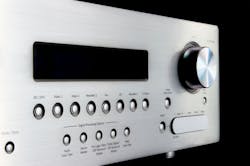AV Receivers: Understanding the Concept and Surround-Sound Formats
What you’ll learn:
- The technology behind AV receivers.
- What are the various surround-sound formats?
- AV receivers enabled with Dolby and DTS technology.
With the outbreak of COVID-19, staying at home and entertaining your family became a daily focal point for many. And what could be a better option than having a complete home-theater setup if you’re a movie lover, sports enthusiast, or video-game aficionado. It brings the cinema to your home, streaming your favorite music/ games with a full theater experience.
But have you ever thought about the actual brain—the audio/video (AV) receiver—working behind the complete home-theater system? AV receivers are the hub of a home-theater system and provide the main source of power (Fig. 1). The main purpose of AV receivers is to receive the audio or video signals from several sources and route those signals through devices like the TV, speakers, monitor, projector, etc.
The Science Behind AV Receivers
The primary function of receivers is to receive, interpret, and process the audio/video signals and transmit them over some output devices. A receiver’s components include:
- AV input/output (S/PDIF, HDMI, USB, RCA)
- Preamplifier
- Surround-sound decoders (Dolby Digital, Dolby TrueHD, Dolby Atmos)
- Power amplifiers (one per channel)
- Output devices (TV, speaker, monitor)
The processing of audio and video signals is simple. The source devices send the audio and video signals to the receiver device. The user chooses which input component needs to be fed to the output device and then the preamplifier selects that signal and amplifies it wherever needed.
Next, the receiver sends the video signals to the output device (TV, monitor, etc.) and audio signals to the decoders. The decoder sorts out different sounds from the video and sends the info to the amplifiers to find their respective channel output. Finally, the sounds are sent to the appropriate speakers.
Surround-Sound Channels Explained: 2.1, 3.1, 5.1, 7.1, and More
In the process of setting up a surround-sound receiver, you will often come across numbers like 2.1, 5.1, 5.1.2, 7.1, 7.1.2, 9.1, and so on. For surround-sound systems, the first number defines the number of main speakers, the second number defines the number of subwoofers, and the third number defines the number of height speakers. For example, 7.1.2 channel speakers have seven main speakers, one subwoofer, and two height speakers that are connected (Fig. 2).
2.0 is a basic stereo speaker system that has two speakers, one to the right and the other to the left side of the TV powered by a receiver or amplifier. Both speakers should be compatible with the TV, DVD, mobile, desktop, etc., and mostly used to listen to music.
A 2.1 stereo sound system comes with a subwoofer that improves the sound quality of a 2.0 system. It provides extra bass and clutter-free experience to the home-theater system and is commonly used to enjoy TV and music.
A 3.1 sound system consists of four speakers—three main speakers are positioned in the left, right, and center and one subwoofer should be positioned in the center of the complete setup. This setup doesn’t provide any surround-sound effects and is used to add effects to enhance the user’s cinematic experience.
5.1 is considered one of the most common system setups as it brings the true surround-sound experience to users. It consists of five main speakers and one subwoofer. Apart from the three speakers at left, right, and center, two surround speakers are positioned in the front and back of the room setup. The system also is widely used in smart TVs, movie theaters, and video games to provide a 360-degree audio experience to listeners.
A 7.1 surround-sound system is an eight-channel system that consists of seven speakers and one subwoofer. Surround speakers are placed to the listener’s position and rear speakers are placed behind the listener. These sound systems are coupled with the Dolby and DTS-enabled sounds to give an immersive experience to users.
Surround-Sound Receivers Enabled with Dolby and DTS Technologies
Advances in audio technologies have given rise to different surround-sound formats over the years. Earlier formats of surround sounds didn’t have multiple channels, but today’s formats do contain multiple channels that result in improved sound with more audio effects and realism.
Until now, the 5.1 surround system format has been the most common configuration in AV receivers, providing true surround sound. More advanced surround systems like 7.1, 7.1.2, and 9.1 use fully discrete channels with extraordinary sound effects.
Let’s explore what makes these surround-sound systems so effective. They use the latest Dolby and DTS technologies to provide the original sound experience without compromising audio quality (Fig. 3).
Dolby Digital
It’s one of the most common surround-sound formats used for 5.1 and 7.1 channel speakers. It’s also called AC-3. Dolby Digital utilizes lossy compression, which loses some of the original sound quality. Nonetheless, it still can provide a greater surround sound experience.
Dolby Digital can be sent over HDMI or coaxial cables. The receiver will decode the signal and play it as surround sound through compatible output devices.
Dolby Atmos
Among all other audio technologies, Dolby Atmos has proved itself to be one of the most impressive technologies due to its object-based immersive surround-sound technology. In Dolby Atmos, the sound is pushed to a particular spot in 3D space through additional high-frequency speakers that can either be mounted on the ceiling or in the front or surround speakers. These ceiling speakers are configured whereby the sounds arrive at the listener’s position as if they’re coming from above. The combination of Dolby Atmos and Dolby Vision creates the Dolby cinema.
Dolby TrueHD
It supports up to eight discrete channels (7.1 sound system) of lossless audio codec, which can provide a good, compressed sound format retaining the original sound quality. The receiver detects this sound format first and then sends it over the HDMI as a bitstream from the source device; the front panel will display “Dolby TrueHD.”
Dolby Digital Plus
Also known as Enhanced AC-3, it can support up to 15 channels and will most likely be used with 6.1 or 7.1 sound systems. It provides better sound quality than standard Dolby Digital 5.1 and can be optimized using compatible devices.
Dolby Digital Plus has become a popular audio format in over-the-top (OTT) services like Netflix, Amazon Prime, Hulu, Disney, etc. It also offers these OTT services with the Dolby Atmos soundtrack at a lower bandwidth. The only requirement is that AV receivers should support Dolby Atmos version, too.
DTS: X
This object-based surround-sound technology provides overhead sound effects to deliver better sound quality similar to Dolby Atmos. The main difference from Dolby Atmos is that it doesn’t require any additional height speakers or any specific number of speakers. The AV receiver must be compatible enough to decode and understand this new type of audio experience.
DTS-enabled receivers use auto-calibration and object-based processors to deliver three-dimensional surround sound to the output speakers. It allows users to manually adjust the sounds and experience it with more realism from all angles.
Today, AV receivers have become much more than handling audio signals as they’re equipped with immersive sounds to augment the listening experience. On top of that, the introduction of the newest sound formats from Dolby and DTS has changed the landscape of the home cinema experience.



